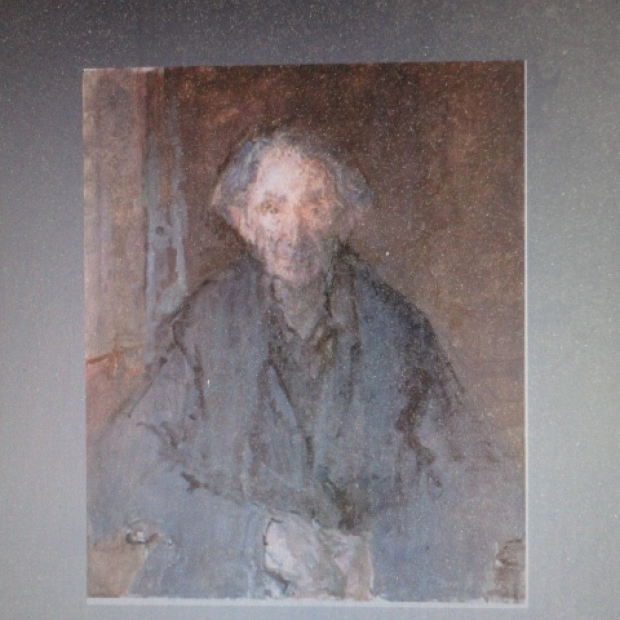Work > Articles
A Dedication to Drawing: Peter Greenham by Roger Wagner
A Dedication to Drawing
Peter Greenham's favourite ambition was to leave one really
good drawing behind him. To that end whatever else he was doing he would draw
every day. His aspiration had much in common with the great Japanese artist
Hokusai, who describing himself as an "old man mad about painting", said in his
ninetieth year that given ten years, no even five years more he might have
become a great painter. As the Keeper of the RA schools from 1964, Greenham preached what he
practised. When I first started at the Academy he warned me that if I wanted to
get anywhere as a painter I would have to do nothing else. A tall man with
untidy grey hair, who looked at you through thick glasses and shuffled around
the schools in carpet slippers, Peter Greenham's teaching method was very
characteristic. If you were doing a drawing he would sit beside you, take your
piece of paper, and do his drawing alongside yours. When he had finished he
would say something to the effect of "like that" and shuffle away. This might not sound very illuminating,
but in fact it was. The idea that a picture is worth a thousand words is never
more true than when a picture is what you are trying to produce. Some students
used to collect Greenham's instructional drawings, and as a gauche new student
one of my most shameful memories is rubbing out one of these drawings, which
seemed to me to spoil my own (when I once told this story at a Reynolds club
dinner faces blanched and there were sharp intakes of breath all round the
room).
Greenham's dedication to drawing set him to some extent at
odds with what has become a common approach in art schools, where drawing and
painting are taught only as possible options that a student can select from a
large smogasbord of potential art practices. In many art schools where new art
forms increasingly crowd out the older ones, students whose whole passion is
for painting are sometimes implicitly and often explicitly encouraged to think
of their preference as somehow reactionary or retrogressive. But even where
this is not the case the almost universal assumption that students should not
specialise in any given art form, but throughout their student career should
continually remain open to whole panoply of art practices, is not necessarily
to their benefit. It is rare to find a professional tennis player who is also a
professional footballer, not because it is impossible to enjoy both tennis and
football, but because the degree of commitment necessary to excel in either is
of an all consuming kind. It would be surprising if excellence in any given art
form did not require a similar level of commitment. Greenham in this sense
followed generations of painters in arguing that it did.
In his own work the fruit of this kind of dedication can be
seen in a picture like his portrait of Sheridan Russell. No photograph of the
painting really conveys the almost magical way that the solid appearance of
Russell's head arises out of such fleeting evanescent touches of oil paint, or
the way that Greenham's ability to draw in paint and his iron grasp of
underlying structure enables him to freely extemporise his brushwork without
for a moment losing touch with reality. If drawing is ˜putting lines around an
idea, then Greenham's painting is a nice demonstration that the strength of an
idea and the means necessary to convey it can be inversely proportional. But
this is far more than simply a technical achievement. There is a peculiar
lyricism in Greenham's handling of paint that is highly characteristic (it is
perhaps no coincidence that he was skilled pianist and kept a grand piano in
his Academy studio). Where a photograph records a momentary appearance in the
blink of a shutter (Cartier-Bresson's "decisive moment") the moment-by-moment
human choices involved in these gestures of paint on canvass, are necessarily
invested with a human meaning that can somehow dramatise the whole nature of an
encounter. A portrait can in this way become a record not just of an appearance
but of a meeting: an engagement in which sitter and
painter are both somehow vividly present. It is not (to put it mildly) an easy
thing to achieve. A mechanically accurate painter with no gift of conveying
feeling in paint can depict a person's appearance with no real sense of having
met them. A more expressive painter can become so preoccupied with the emotions
expressed in paint that the person who is their source fades from view. But
where, as in Greenham's portrait of Russell, the fragile balance between these
two things is miraculously attained, the result is something uniquely and
luminously human.
In an introduction to a New English Art Club catalogue Jane
Greenham describes how Peter, though rapturous whenever he sold a painting,
endorsed the remark of his own teacher F.E Jackson that "you can't do things and
get the credit for them. Getting credit is a full time job". It was an attitude
far removed from the idea of gaining notoriety through what Merlin James has
described as the art world's "fickle mixture of net-working and hustling and
luck and fashion fluctuations". While in one sense Peter coveted the applause
received by musicians, in another and deeper sense he was almost indifferent to
how he was received (when he went along to the Palace to paint the Queen,
dressed in his usual somewhat shabby suit, the doorman thought he was a tramp
and tried to turn him away). Yet while such indifference to applause may be a
necessary attribute in an artist striving to produce any kind of masterpiece, a
society which values such masterpieces would be unwise to permanently sit on
its hands: a major retrospective of Greenham's work is long overdue.
Roger Wagner

